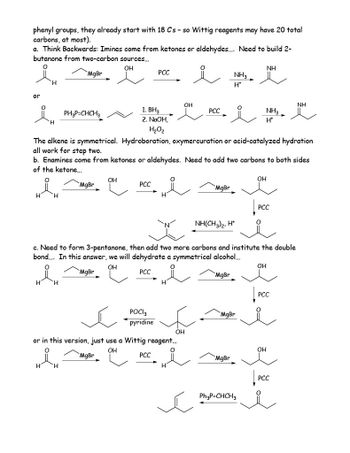
Chemistry
10th Edition
ISBN: 9781305957404
Author: Steven S. Zumdahl, Susan A. Zumdahl, Donald J. DeCoste
Publisher: Cengage Learning
expand_more
expand_more
format_list_bulleted
Question
Could you show the mechanism for Question 4, parts A-C?

Transcribed Image Text:phenyl groups, they already start with 18 C's - so Wittig reagents may have 20 total
carbons, at most).
a. Think Backwards: Imines come from ketones or aldehydes.... Need to build 2-
butanone from two-carbon sources...
MgBr
or
H
H H
PH3P=CHCH3
H
H
OH
e
MgBr
H
OH
1. BH3
2. NaOH,
H₂O₂
The alkene is symmetrical. Hydroboration, oxymercuration or acid-catalyzed hydration
all work for step two.
PCC
b. Enamines come from ketones or aldehydes. Need to add two carbons to both sides
of the ketone...
PCC
I
or in this version, just use a Wittig reagent...
O
OH
MgBr
OH
POCI 3
pyridine
PCC
PCC
X
c. Need to form 3-pentanone, then add two more carbons and institute the double
bond.... In this answer, we will dehydrate a symmetrical alcohol...
OH
MgBr
PCC
MgBr
OH
NH3
H*
MgBr
NH(CH3)2, H*
NH
I
MgBr
MgBr
Ph3P=CHCH3
NH3
H*
OH
PCC
OH
PCC
NH
çoğça fo
PCC

Transcribed Image Text:3. Construct the following compounds using only the following carbon sources and
whatever other inorganic reagents (oxidants, reducing agents, etc): formaldehyde,
acetaldehyde, acetone, 1-butanol.
a. 4 Carbons becoming 5 Carbons - Need to add one more carbon (must be using
formaldehyde)... Thinking backwards - Alcohols form from Grignards reacting with
aldehydes... Need to make a Grignard...
PBr3
H&H
OH
НО.
OH
Br
b. 4 Carbons becoming 6 Carbons - Need to add two more carbons (must be using
acetaldehyde). Thinking backwards - Chlorides come from alcohols, alcohols come from
Grignards with aldehydes... Need a four carbon Grignard...
PBr3
Mg
PBr3
Br
Mg
Br
MgBr
Mg
CI
c. 4 Carbons becoming 7 Carbons - Need to add three more carbons (must be using
acetone). Thinking backwards - Alkenes come from the dehydration of alcohols, alcohols
come from Grignards with ketones... Need a four carbon Grignard...
BrMg.
MgBr H
OH
OH
OH
SOCI₂,
pyridine
{d}
POCI3
pyridine
more than
4. For the following compounds, construct them from reagents containing no
two carbons (with the exception of any Wittig reagent you would like to use with three
Expert Solution
This question has been solved!
Explore an expertly crafted, step-by-step solution for a thorough understanding of key concepts.
Step by stepSolved in 2 steps with 2 images

Knowledge Booster
Learn more about
Need a deep-dive on the concept behind this application? Look no further. Learn more about this topic, chemistry and related others by exploring similar questions and additional content below.Similar questions
- What's the mechanism?arrow_forwardStep 1) 2) 3) 4) 5) 6) CI-CI hv CH₂ + Cl CH3 + CI-CI ci + CH3 CH3 + CH3 ci + ci 2 CI* of the mechanism steps shown is the rate-determining step for the chlorination of methane. CH3 + HCI CH3Cl + Ci CH3CI CH3CH3 CI-CIarrow_forwardWhat is the correct mechanism numberarrow_forward
- Chemistry 1-bromo-1-methylcyclopropane + H2O → 1-methyl cyclopropane + HBr bromocyclopropane + H2O → cyclopropane + HBr Can I get a detailed description of the mechanism of these two reactions? (Specify each specific step and talk about how it happened.).arrow_forwardPls help ASAP. Pls show all work. If its false then pls make sure to write the correct statement and why it is false.arrow_forwardxxxxviarrow_forward
arrow_back_ios
arrow_forward_ios
Recommended textbooks for you
 ChemistryChemistryISBN:9781305957404Author:Steven S. Zumdahl, Susan A. Zumdahl, Donald J. DeCostePublisher:Cengage Learning
ChemistryChemistryISBN:9781305957404Author:Steven S. Zumdahl, Susan A. Zumdahl, Donald J. DeCostePublisher:Cengage Learning ChemistryChemistryISBN:9781259911156Author:Raymond Chang Dr., Jason Overby ProfessorPublisher:McGraw-Hill Education
ChemistryChemistryISBN:9781259911156Author:Raymond Chang Dr., Jason Overby ProfessorPublisher:McGraw-Hill Education Principles of Instrumental AnalysisChemistryISBN:9781305577213Author:Douglas A. Skoog, F. James Holler, Stanley R. CrouchPublisher:Cengage Learning
Principles of Instrumental AnalysisChemistryISBN:9781305577213Author:Douglas A. Skoog, F. James Holler, Stanley R. CrouchPublisher:Cengage Learning Organic ChemistryChemistryISBN:9780078021558Author:Janice Gorzynski Smith Dr.Publisher:McGraw-Hill Education
Organic ChemistryChemistryISBN:9780078021558Author:Janice Gorzynski Smith Dr.Publisher:McGraw-Hill Education Chemistry: Principles and ReactionsChemistryISBN:9781305079373Author:William L. Masterton, Cecile N. HurleyPublisher:Cengage Learning
Chemistry: Principles and ReactionsChemistryISBN:9781305079373Author:William L. Masterton, Cecile N. HurleyPublisher:Cengage Learning Elementary Principles of Chemical Processes, Bind...ChemistryISBN:9781118431221Author:Richard M. Felder, Ronald W. Rousseau, Lisa G. BullardPublisher:WILEY
Elementary Principles of Chemical Processes, Bind...ChemistryISBN:9781118431221Author:Richard M. Felder, Ronald W. Rousseau, Lisa G. BullardPublisher:WILEY

Chemistry
Chemistry
ISBN:9781305957404
Author:Steven S. Zumdahl, Susan A. Zumdahl, Donald J. DeCoste
Publisher:Cengage Learning

Chemistry
Chemistry
ISBN:9781259911156
Author:Raymond Chang Dr., Jason Overby Professor
Publisher:McGraw-Hill Education

Principles of Instrumental Analysis
Chemistry
ISBN:9781305577213
Author:Douglas A. Skoog, F. James Holler, Stanley R. Crouch
Publisher:Cengage Learning

Organic Chemistry
Chemistry
ISBN:9780078021558
Author:Janice Gorzynski Smith Dr.
Publisher:McGraw-Hill Education

Chemistry: Principles and Reactions
Chemistry
ISBN:9781305079373
Author:William L. Masterton, Cecile N. Hurley
Publisher:Cengage Learning

Elementary Principles of Chemical Processes, Bind...
Chemistry
ISBN:9781118431221
Author:Richard M. Felder, Ronald W. Rousseau, Lisa G. Bullard
Publisher:WILEY